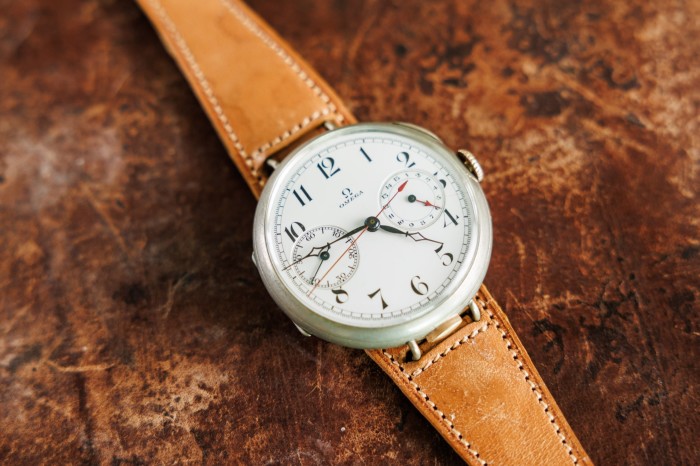watch dealer Andy Tolley’s flights of fancy

Andy Tolley is a “modern-day Indiana Jones” in his collecting of vintage watches. “I’ll buy the archives and things like that because I want to piece together the history,” he says. He enjoys hunting for early photographs, advertisements, and flight logs to contextualise his pieces.
His interest in watches began when he bought Seikos during a trip to Malaysia as a teenager in 1987 — although the “catalyst” was a 1950s Breitling Navitimer he purchased back home in Australia, in his early twenties. “From there, it cascaded into an avalanche of buying and selling, and then collecting,” says the semi-retired watch dealer, now living in Thailand. “I ended up with this deep love of aviation watches.”
About 100 of his 500 pieces are pilot watches, dating from 1910 to the mid-1970s, which he has accumulated over the past 15 years. “The pilot watches are interesting because they’ve got the stamp of history on them,” says Tolley, who is particularly fascinated by the interwar period because of its “larger-than-life characters” and technical advances. “They were essential instruments for incredible aviators and aviatrices in a defining period that shaped the world that we know today.”
Omega Ref CH 168.18 (1915)

Omega produced its first wrist chronograph in 1913. In 2018, the brand released a limited edition of 18 pieces featuring the original 18’’’ CHRO movement from that watch. Tolley’s chrome piece features the same one. “They were morphing from a pocket watch into a wristwatch, so they were still using pocket watch calibres,” he says.
The piece, bought at a UK auction, came with a black-and-white photograph of a man holding a bomb out of an aeroplane. Tolley assumes he was the watch’s original owner.
Prototype Longines Weems Second Setting watch (1929)

In Tolley’s opinion, Longines made the most important pilot watches of the interwar period. US naval officer Philip Van Horn Weems, a pioneer in the field of navigation, collaborated with the Swiss manufacturer to design a wristwatch with an inner-rotating 60-second dial that enabled a pilot to synchronise the watch to a radio time signal.
The BBC had introduced the Greenwich Time Signal (six “pips” on the hour) to radio broadcasts in 1924.
“With that watch, you could turn the inner chapter forwards or backwards and increase the accuracy of the watch by 30 seconds,” says Tolley. This made it a “critical instrument” for navigation, he adds, describing Weems as “the grandfather of our GPS system”.
Tolley’s silver piece, which he says is a prototype made in 1929 with a pocket watch movement intended for the Turkish market, was supplied to Longines’ UK agent Baume & Co in 1930. He was tipped off about its appearance at auction by dealer Paul Pfanner, of Timewise Vintage Watches, who is taking part in the Lapada Berkeley Square antiques, art and design fair in London later this month.
Longines Lindbergh Hour Angle watch (1933)

American aviator Charles Lindbergh made the first nonstop flight between New York and Paris in 1927, sparking increased interest in aviation. He then collaborated with Longines on a watch, first produced in 1931, that pilots could use to calculate longitude in conjunction with a sextant and a nautical almanac. This watch has an engraved rotating bezel.
Longines sold Tolley’s silver version to its French agent in 1937. Tolley attributes the delay between manufacture and delivery to a collapse in sales because of the Great Depression. This piece and his Weems-type watch retain their original straps and buckles, he says, and were tool watches that pilots trusted “with their lives”. Tolley hopes to stage a public exhibition of his pilot watches to coincide with the 100th anniversary of Lindbergh’s Atlantic crossing in 2027.
Breitling Navitimer (1969)

Tolley seeks a “wow, wow, wow factor” with watches, driven by condition and rarity. “I like something that somehow miraculously has survived in beautiful or outstanding condition,” he says. “Somehow, it hasn’t been dropped, hasn’t gone for a swim, hasn’t been abused by putting olive oil in it [during repair].”
It was its “exquisite” condition that attracted him to this Navitimer. Breitling introduced the model after being approached in 1952 to make a chronograph for members of the US Aircraft Owners and Pilots Association. The watch features a slide-rule bezel that helped pilots make calculations of, for example, average speed, distance travelled and fuel consumption.
Tolley considers the Navitimer to be among the five most important pilot watches. However, he suspects that aviators used a stainless steel version, rather than a gold piece like the one he bought in Japan.
Breitling Navitimer Ref 8806 (1973)

Tolley’s stainless steel Navitimer, which has an automatic movement, was supplied to the United Arab Emirates in 1973, although his research suggests the then fledgling country had “no actual need for a military watch” at that time. He says the piece, which features the UAE crest on the dial, is “very unusual”; he estimates that fewer than 40 were made.
Tolley likens watch collecting to doing a jigsaw, except you don’t know what the picture looks like “and it’s not about how many pieces you end up with”.
One piece missing from his puzzle, he says, is the first-generation 32mm Lindbergh Hour Angle watch. The hunt goes on. “The game never ends,” says Tolley.
#watch #dealer #Andy #Tolleys #flights #fancy






